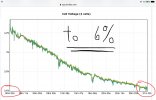I don't doubt you. A brief review of my M3 AirData logs reveals that 3.5V under load is still not being reached at 6% remaining battery, when my landing goal is between 5% and 10%. As you can see in the AirData "Cell Voltage ((4 cells)” graph below, it doesn't even drop below 3.6V at 6% remaining under load. That is consistent with your 3.60V under load trigger to land, except on the M3, it's around 6% remaining battery, instead of 20-30% remaining battery.Anything below 3.5V under load is playing with fire. It ages the battery quickly and once you've done it enough times, your battery's voltage will sag when you don't expect it.

Last edited:










